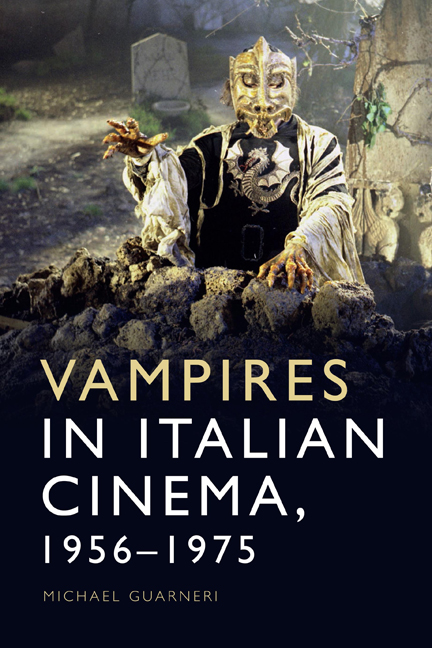Book contents
- Frontmatter
- Contents
- Figures and tables
- Acknowledgements
- Introduction
- PART I THE INDUSTRIAL CONTEXT
- PART II VAMPIRE SEX AND VAMPIRE GENDER
- PART III SANGUINE ECONOMY, BLOODY POLITIC
- Appendix A Three Italian vampire films that were never made
- Appendix B Files from the Italian Show Business Bureau fonds at the Archivio Centrale dello Stato in Rome
- Bibliography
- Index
3 - Female vampires
Published online by Cambridge University Press: 10 October 2020
- Frontmatter
- Contents
- Figures and tables
- Acknowledgements
- Introduction
- PART I THE INDUSTRIAL CONTEXT
- PART II VAMPIRE SEX AND VAMPIRE GENDER
- PART III SANGUINE ECONOMY, BLOODY POLITIC
- Appendix A Three Italian vampire films that were never made
- Appendix B Files from the Italian Show Business Bureau fonds at the Archivio Centrale dello Stato in Rome
- Bibliography
- Index
Summary
BURN WITCH BURN: THE FEMALE VAMPIRES of 1956–1965
Together with Italy's scant heritage of literary horrors, the parasitic dynamics of filone-filmmaking explain why most Italian vampire movies imitate foreign hits, starting from the Hammer Dracula. In many cases, however, such ‘cinema of imitation’ (Baschiera 2016) did not produce slavish plagiarisms, but more or less creative variations on the templates established by foreign vampire films. Indeed, in spite of Italian vampire cinema's imported and derivative nature, ever since the late 1960s historians of the horror film have identified some elements of Italianness in Italian Gothic horrors, namely the centrality of female characters and the influence of the nineteenth-century melodrama on movie plots (Clarens 1968: 190–4; Mora 1978: 289–342; Troiano 1985 and 1989). These seminal suggestions came to dominate current academic discourses about Italian horror, as best exemplified by the thematic analyses of the Gothic horror filone put forward by Pezzotta (1997 and 2014), Della Casa (1990, 2000 and 2001c), Di Chiara (2009) and Curti (2011). From Mora (1978: 292), in particular, these four scholars borrow the premise that, instead of focusing on male monsters and male stardom like Universal and Hammer, Italian Gothic horror ‘takes as its central figure […] the woman’ as the ‘catalyst of a moral monstrosity’ connected to the typically melodramatic themes of ‘sin, guilt and evil (all of them sexually connoted)’. Pezzotta (1997 and 2014), Della Casa (1990, 2000 and 2001c), Di Chiara (2009) and Curti (2011) then proceed to map their assumptions onto the thirty-something horror films made in Italy between 1956 and the mid-1960s and, true to the Manichean ‘logic of the excluded middle’ that Brooks ([1976] 1995: 18) sees as the key feature of the nineteenth-century melodramatic imagination, split Italian Gothic horror's leading ladies into irreconcilable opposites: hyper-sexed, proactive villainesses (wicked human beings, vampires, witches, ghosts or a combination thereof) and chaste, passive damsels in distress – the two mutually exclusive archetypes generally marked via different hair colour.
Focused on I vampiri, Il mulino delle donne di pietra and La maschera del demonio, the most extensive analysis of the Italian female vampire to date is Di Chiara's (2009: 51–119). Combining semiotics and structuralist anthropology, the author conceives of Italian vampire horrors as sexual morality plays that somewhat differ from the Hammer Dracula's template.
- Type
- Chapter
- Information
- Vampires in Italian Cinema, 1956-1975 , pp. 77 - 106Publisher: Edinburgh University PressPrint publication year: 2020



